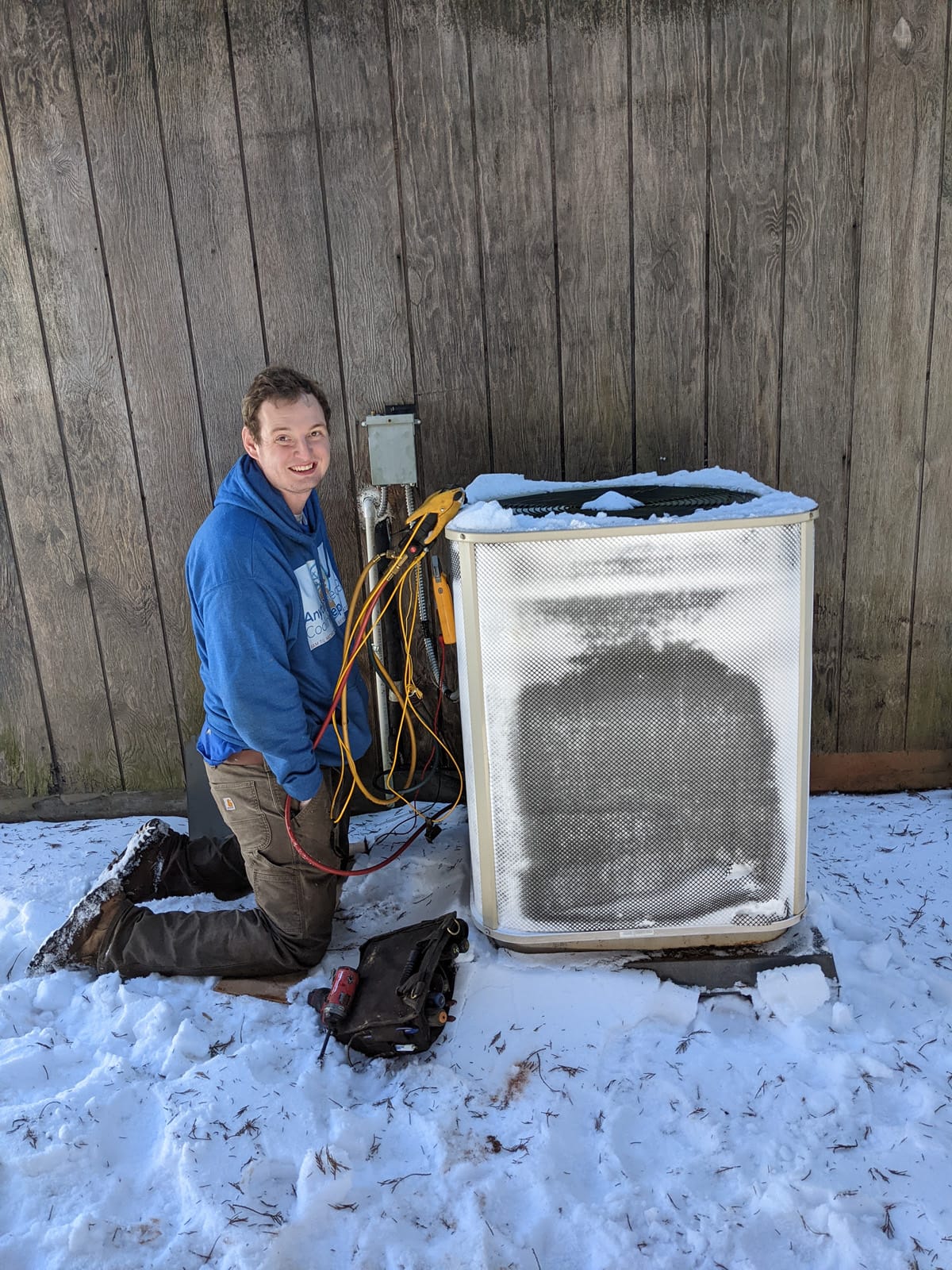
Let’s talk about something crucial but often overlooked: leak detection in your HVAC system. Why is it so important, you ask? Well, for starters, it keeps your system running smoothly and efficiently. But there’s more to it than just that.
You might wonder how these leaks get spotted in the first place. Enter trained technicians with their eagle eyes. These pros don’t just give your system a once-over; they dive deep with visual inspections to catch any potential issues.
Why place your trust in mere visual assessments? It’s simple yet effective. Spotting signs of wear or damage early can save you from bigger headaches down the road like refrigerant leaks – those pesky problems that mess with efficiency and hit you where it hurts: your wallet.
But why should we care?
This isn’t just about keeping cool during summer or warm in winter; it’s about ensuring our comfort doesn’t cost us more than necessary or harm the planet. And while the EPA has regulations aimed at reducing these impacts by requiring proper maintenance and repair of refrigeration equipment, real change starts with awareness and action at home or work.
In essence, having skilled technicians routinely employ reliable techniques such as visual examinations is key to preserving an effective and durable HVAC system, which in turn lessens our ecological footprint. So next time you book a service visit, remember – those checks are worth every penny for peace of mind alone.
Spotting leaks early with trained eyes saves money, energy, and the planet. Regular tech checks keep your HVAC efficient and eco-friendly.
When it comes to keeping refrigeration equipment in top shape, spotting leaks early is key. But how do pros make sure they catch every hiss and bubble? Embarking on an exploration of leak discovery, we plunge into the nuances that make it both an art and a science.
Gone are the days when you had to guess where a leak might be hiding. Today, sensitive sensors have changed the game. These little heroes can sniff out even the tiniest escape of refrigerant gas, making them a must-have in any HVAC technician’s toolkit. Nowadays, technicians can use either an electronic sniffer or a sophisticated infrared gadget to identify leaks with astonishing precision.
If sensitive sensors are Batman in our fight against leaks, then UV dye is definitely Robin. This method involves injecting a fluorescent dye into the system which circulates with the refrigerant. Wherever there’s a leak, this sneaky dye makes its exit too but leaves behind a visible mark under UV light—like leaving breadcrumbs for techs to follow straight to the source.
This technique doesn’t just find leaks; it shows their exact location like nothing else can. And while some may worry about introducing something new into their system, the benefits often outweigh concerns. Most dyes used today are designed not to harm your equipment, making this approach both effective and safe.
Detecting leaks has never been more straightforward—or high-tech.
So next time you think about skipping on regular checks, remember: innovation has made finding those pesky leaks easier than ever before. Detect early, fix fast.
Leak detection has leveled up with sensors and UV dye, making it easy to spot even the smallest leaks. This tech not only saves time but also extends your system’s life. Think high-tech for hassle-free maintenance.
Finding leaks in refrigeration and air conditioning systems is a bit like detective work. Solving the mystery of leaks in these systems demands having the proper gadgets at your disposal. Let’s dive into some top gear that pros use.
First up, we’ve got electronic leak detectors. These gizmos are all about precision. They sniff out refrigerant gas, giving technicians a heads-up on where trouble’s brewing. Think of them as highly trained sniffer dogs for your HVAC system.
An electronic detector works by sensing changes in chemical concentration in the air. When it hits an area with refrigerant gas, bam. It signals a leak.
This tech comes in various forms – from simple handheld units to more sophisticated models equipped with infrared technology or heated diodes for those tiny, hard-to-find leaks.
Moving on to something simpler but equally effective – the bubble solution method. Yes, it sounds like kid’s play, but trust me; this method has been around because it works great.
This approach doesn’t require fancy equipment and offers visual confirmation – seeing is believing after all. Moreover, there’s a certain joy in observing bubbles burst, isn’t there?
In both methods – whether you go high-tech with an electronic sniffer or keep it classic with soap suds – finding and fixing those pesky leaks not only keeps your system running smoothly but also protects our environment from harmful gases escaping into the atmosphere.
Got a sneaky suspicion that your refrigeration system is leaking? You’re not alone. Detecting and mending leaks is essential in maintaining system efficacy and safeguarding our surroundings.
A pressure test? Yes, it’s like giving your refrigeration system a physical exam to make sure everything’s in tip-top shape. Here’s how it goes down:
Implementing this technique does more than just validate our hunches; it aligns with legal standards, safeguarding the machinery and shielding our invaluable ozone layer from the detrimental effects of fleeing gases such as Chlorofluorocarbons and Hydrochlorofluorocarbons.
Sure, it might sound straightforward but remember: conducting these tests needs expertise – we’re talking Sherlock Holmes-level attention to detail here. Plus, there are other methods too – UV dye injections or electronic sniffers anyone?
In essence, whether you’re running an ice cream shop or managing commercial HVAC systems at skyscraper scale – knowing how to check for those pesky refrigerant leaks can save money on repairs, keep efficiency high, and help Mother Nature breathe easier too.
If only detecting why my car makes that weird noise when I start it was as easy…
When it comes to our planet, every little action counts. And that includes fixing refrigerant leaks in your HVAC system. Why? Because these leaks are not just a headache for your air conditioning maintenance bill; they’re also punching holes in the ozone layer and cranking up global warming.
You’ve probably heard about the ozone layer since grade school. Imagine it as our planet’s own protective lotion, warding off the nasty sunburns caused by those intense UV rays. But when refrigerants leak, they release chemicals into the atmosphere that break down this protective barrier. Think sunburn for our planet.
Escaping into the atmosphere, these refrigerants don’t just harm the ozone; they’re formidable adversaries in trapping heat, acting as powerful accelerators of global warming. They trap heat in our atmosphere much more effectively than carbon dioxide does – making them heavyweight contributors to global warming.
Detecting and sealing these leaks is crucial – not only to keep your energy bills low but also to protect Mother Nature herself. The EPA emphasizes reducing HFC emissions, underlining how serious this issue is on an environmental scale. So next time you hear hissing or notice frosting from your cooling unit, remember: Acting fast doesn’t just save pennies; it saves polar bears too. Let’s patch things up with our planet one leak at a time.
Owning or managing commercial refrigeration comes with its set of challenges, right? One sneaky issue that can creep up is refrigerant leaks. These not only affect your system’s efficiency but also hit you where it hurts—the wallet.
First things first, regularly check your system’s pressure levels. A drop in pressure could be shouting “leak” at you. Don’t ignore it.
Your best bet to catch those elusive leaks is by having a pro take a look. Yes, I mean regular inspections by trained technicians who know exactly what they’re looking for.
The trick isn’t just finding the leak; it’s about staying ahead before they balloon into bigger problems (pun intended).
Last but not least, keep tabs on your refrigerant levels regularly—this helps in early detection if there’s any sudden decrease which might indicate a leak. Monitoring equipment continuously checks this so consider investing if you haven’t already.
To wrap this up: Stay vigilant with scheduled maintenance and use the right tools when suspecting a leak—it saves time and money down the road while keeping your operations smooth sailing. Remember, preventing damage from leaks starts long before actual dripping begins; it starts with awareness and action.
Ever had that moment when your leak detector cried wolf? Yeah, false positives can be a real headache. They send you on wild goose chases and waste precious time. But don’t sweat it; we’ve got some strategies to keep those pesky false alarms at bay.
1. Know Your Equipment:
2. Regular Calibration:
3. Cross-Verification Techniques:
To sum it up, dealing with false positives requires patience, knowledge, and a bit of detective work. But hey, equipped with these tips and tricks, you’ll cut down on frustration—and ensure that when your detector speaks up, it’s worth listening to. Remember: every mistake is just learning in disguise. With each challenge comes greater expertise, turning today’s oops into tomorrow’s eureka moments. So gear up, sharpen those skills, and let’s make those false positives a thing of the past. Together, we’ve got this.
Together, we embarked on a journey into the enigmatic realm of HVAC systems, discovering the quiet champions battling against waste and ecological damage. Like a detective novel with twists at every turn, leak detection emerged as our hero—unassumingly powerful and crucially important.
We’ve walked through gardens not of flowers but of innovation, where trained technicians wield tools like modern-day wizards. Their spells? Sensitive sensors and UV dyes that light up problems invisible to the naked eye. And let’s not forget about those trusty electronic detectors or simple bubble solutions – oldies but goodies in spotting those elusive leaks.
This tale isn’t just about saving on energy bills; it’s a saga with higher stakes – protecting our planet from ozone depletion and global warming. Every repaired leak is a victory in this grander battle for sustainability.
The knowledge shared here is more than just tips; it’s empowerment. With advanced technologies like infrared lights at our disposal, pinpoint accuracy isn’t just possible—it’s within reach. Yet, mastering the art of dodging false alarms is a testament to how, even amidst our tech-savvy era, the discernment and wisdom of humans are irreplaceable treasures.
Consider this journey through HVAC efficiency akin to unearthing buried treasure right within your walls—a secret garden indeed! Only instead of gold coins or ancient artifacts, you’re armed with something far more precious: understanding how small fixes lead to monumental impacts both financially and environmentally.
In essence? It’s clear now why keeping those sneaky leaks in check can mean everything for your comfort zone.

2901 N Main Ave
Newton, NC 28658
Mon - Sun Open 24 Hours
No Overtime Charges
Call to Schedule Service
(828) 838-0973